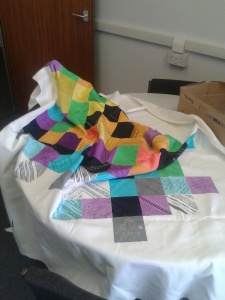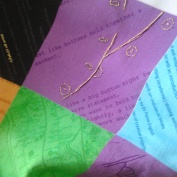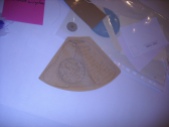This year’s HEA Arts and Humanities conference was held in Brighton this week.
 I had been thinking about architecture as a structure for my reflective book of it somehow – the idea of ‘housing’ the different stories told in the sessions somehow… and as I looked out to the pier over breakfast I really liked that structure – the somewhat fantastic structures you find on a pier of this sort, not unlike best practice in Higher Education, underpinned by a supporting structure. And then the conference started and I didn’t really have much time to think about anything much beyond what session to go to next (and at this event those were very difficult decisions). As I don’t have the time to get into the making of my reflective book just now, here a little write-up of the impressions of my very own conference experience…
I had been thinking about architecture as a structure for my reflective book of it somehow – the idea of ‘housing’ the different stories told in the sessions somehow… and as I looked out to the pier over breakfast I really liked that structure – the somewhat fantastic structures you find on a pier of this sort, not unlike best practice in Higher Education, underpinned by a supporting structure. And then the conference started and I didn’t really have much time to think about anything much beyond what session to go to next (and at this event those were very difficult decisions). As I don’t have the time to get into the making of my reflective book just now, here a little write-up of the impressions of my very own conference experience…
We got started with a keynote by Dr Vicky Gunn, Director of Learning and Teaching Centre at the University of Glasgow, who talked about ‘Stories as re-membering: The tall tales we tell about teaching‘. It was a rich hour with lots to think about. What stuck with me most was the image of the emic mountain, and how you tend to think/reflect back on what you thought was going on, rather than on what was actually going on. What also got me thinking was the question whether we are using our teaching to produce gated communities rather than public squares, through the exclusivity of the ‘conversations’ we are having and are encouraging our students to have.
I then dove into a wildcard session led by Alex Moseley of the University of Leicester on ‘Who needs time and money? How to design cheap and effective traditional games‘ Here I found myself part of the Tibetan team in the World Speed Games Design Championship, using ten steps defining the Context, developing the Grand Design and then Refining the Design of a game that would allow students to build their vocabulary in a foreign language. It became a set of challenges on their (virtual) way to the Cannes Film Festival and involved zombies and meerkats at one point (don’t ask). We didn’t win (partly due to my absolute inabiblity to get us extra points by remembering the favourite games of the other members of my team), but we did learn how to create a learning game in ten steps – and as we only had 90 minutes it became clear that a game like this can be created in prototype fairly quickly. (For more information on creating low-cost games for learning see Whitton, N. and Moseley, A. (2012) Using Games to Enhance Learning and Teaching: A Beginner’s Guide. Routledge).
I spent my afternoon in the three hour session led by Nick Monk of the University of Warrick on ‘Learning from Narrative‘. This combined two activities, which we did in two groups of four. We started by going on a ‘long short walk’. The idea behind this is to slow down and notice things. So, we were required to take a walk that would usually take about 5 minutes and complete it in 20, while really noticing things. It is funny how you immediately pick up on things that your brain usually would filter out, for example the noise of the busy King’s Road, the pole with the odd looking construction, which might have been a camera – but also how there are things you on your own still don’t notice. I for example, didn’t see the Punch and Judy theatre/booth until Sharon pointed it out. They were gone when we went back. This activity reminded me of two things that have made an appearance on this blog before: the documentary drawing, as this is also about noticing things in a different way (and indeed, I tried to do my noticing here through drawing rather than writing), as well as the reflective walk. However, a link I hadn’t made that Nick pointed out once we were back in the room to discuss the experience was that he uses this to illustrate to his students the difference between reading and ‘close reading’ – because when you read for academic research purposes you are not just trying to get from A to B (so that you can say that you have read a particular text), you are trying to notice the nuances, pick up on the meaning, in short pay closer attention. I will definitely be trying that with my students next term! We then went into the second activity of the afternoon, ‘theory building’. Here we got a collection of materials – quotations and images that were all somewhat Brighton related – and were asked to use them to create out own narrative, possibly inspired by our experience of Brighton on our long short walk. After figuring out what everything was and possibly meant, it was really helpful to talk through different options, but in the end this came together in my group once we started to take away things. Our story became stronger once we removed items and only kept the ones that supported the story, rather than keep everything in. Again a very useful activity to do with students, showing the usefulness (and necessity) of developing a focus and editing the story you want to tell. Fascinating was that the other group had a very different approach and put together a small performance!
After this already very full day I felt conference fatigue setting in and decided to skip the next session, being ready for the poster reception afterwards. Here I particularly enjoyed Anna Lise Gordon’s ‘The mirror in the suitcase‘ on the importance of resilience for early career teachers. She uses creative writing methods to explore reflective practice, and I was particularly taken by the Haikus some of her research subjects had written.
We ended the day with the conference dinner, where I had some very interesting conversations about employability – and how that is such a difficult concept to define. Surely people realise that the employability skills you need depend on the job you want? There was also much talk about Skandinavian drama…
The second day started with Professor Hamish Fyfe, the director of the George Ewart Evans Centre for Storytelling. Another thought provoking keynote. What I particularly took away from it was that Stories are not true, but by being untrue they make you understand the truth (after Salman Rushdie). And I started to think about whether written stories are taken more seriously than told stories, and whether that is because stories are inherently personal and therefore seen as subjective (and qualitative), which in an academic community that is very much based on a scientific model might still be seen as inferior to the objectivity of numbers?
Afterwards there was Pat Francis’ and my workshop called Take a Little Button, where the 13 people brave enought to show up got to play around with buttons and consider different ways of using humble/ordinary objects such as buttons in their teaching to explore and explain academic practice. Pat particularly highlighted her work with fashion students on teasing out a context with a button as starting point and I talked about my way of likening buttons to quotations and handed out the newest in my series of tactile academia books, The Button Connection (will blog about this in more detail soon, I hope).
The feedback we got was very positive. People particularly liked how this way of ‘analogue’ working can support and complement the digital methods so much more common these days. There was also a particular sense that these strategies could help particularly when working with objects from an archive. And of course there was much admiration for the packs of random writing materials Pat had put together in preparation, a particular favourite in this workshop was the coffee filter – a great surface for writing on as unexpected things happen…
Here some of the feedback we collected (we want to make some sort of artefact out of it one of these days, so far these are the ‘raw materials’ we have to work with:
In the afternoon it was back to parallel sessions. I sat in on Olaojo Aiyegbayo’s talk ‘Metaphors we teach by: National Teaching Fellows’ metaphorical images of teaching in UK Universities‘, which identified how seasoned practitioners describe their teaching. One of the things that I am taking away from this was an image of a fish jumping out of the water, as Olaojo stated a fish isn’t aware of the water until her is out of it, just like metaphors are part of everyday life so that we need to work at them to become aware of the. It struck me that this might be a good way of visualising the ‘hidden’ academic practice I go on about – students can’t see a lot of it unless we take the jump and make it visible to them!
This session was followed by Amanda Couch talink about ‘A reflection on digestion: embodiment and the professional‘, which was interesting not just for the metaphor of digestion itself, but also for the links between the academic and personal, the bodily and the intellectual.
After a little break I found myself in the last parallel session of the day. Here I learned about ‘Academic staff perceptions of IT in the Humanities‘ by Pritpal Sembi of the University of Wolverhampton, reflecting on a work in progress that shows that it is not just the students who need to be considered individually when it comes to IT, but also the staff, who have their own hopes and fears when it comes to the introduction of new tools and systems. This was followed by an interdisciplinary (and interinstitutional) session on ‘Pioneers on the frontiers of learning?‘ by Rosemary Scott, Sarah Cousins and Dounia Bissar, that again talked about the personal approaches lecturers have to emerging and established digital technologies. This session finished with Zoe Johnson and Andrew Walsh from the University of Huddersfield talking about ‘Finding paths through the information forest‘. Important points made here was the difference between the information searches that you need to make when planning a holiday and the ones for academic research, and that there seem to be two main approaches subscribed to by lecturers: the ‘traditional’ approach of reading lists and letting students find familiar, ‘classic’ sources, and the more ‘practice as research’ approach of a more serendipidous exploration of sources that might come in useful and might challenge (established?) thinking.
By now I was absolutely exhausted and I almost didn’t make it to the closing keynote, but I am so glad I did (being fortified by two cups of tea). Nik Powell, director of the National Film and Television School, managed to pull off a very entertaining presentation, which reminded me that at the end of the day it is the story that is at the centre and that should determine the medium – something that needs to be kept in mind whether you are trying to make films or teach anybody anything!






























